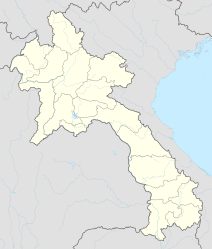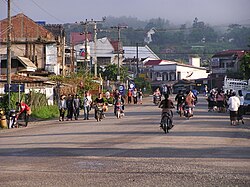Muang Xay
|
ເມືອງ ໄຊ Muang Xay |
||
|---|---|---|
|
|
||
| Coordinates | 20 ° 41 ′ N , 101 ° 59 ′ E | |
| Basic data | ||
| Country | Laos | |
| Oudomxay | ||
| ISO 3166-2 | LA-OU | |
| founding | 1260 | |
| Website | www.oudomxay.info (English) | |
|
Street scene in Muang Xay
|
||
Muang Xay ( Lao ເມືອງ ໄຊ ; also: Oudomxay , Lao: ອຸ ດົມ ໄຊ ) is the capital of the Oudomxay Province in northwest Laos .
Naming
According to legend, in 1323 the people of Ban Cheng village went to the forest to cut bamboo. When they were making fishing utensils out of the bamboo, they saw a monk approaching them from the thicket of the forest, who had withdrawn there long ago to practice meditation. He asked the residents of the village what they were doing, and they replied that they made fish traps. The inhabitants offered the monk food. Because of this encounter, the name of the village was changed from the old name "Takka Sila" to "Muang Xay" ("City Xay"), as the monk's name was Pakxay.
history
In 1987, Muang Xay became the capital of Oudomxay Province in place of Ban Nahin .
According to local history books, Lao Ly settled in Oudomxay around 1260 , who came from the Sipsongpanna ("twelve thousand rice fields") region in southern China. They founded a village called Ban Luang Cheng ("big village"), which laid the foundation for today's Muang Xay. Ban Luang Cheng is now a district of Muang Xay, called "Ban Cheng" for short.
Infrastructure
Oudomxay is connected to Luang Prabang by National Road 13 .
The city has a domestic airport ( IATA : ODY, ICAO : VLOS) that is served by Lao Airlines . There are flights to and from Vientiane three times a week . The airport is a five-minute drive from the city center.
The city is generally supplied with electricity.
Demographics
Mainly Lao Loum live in the city , but the influence of the Khmu ethnic group - around 60% of which are represented in the entire province - is very noticeable. Many ethnic Khmu who have moved from villages live and work in Muang Xay, as there are better opportunities to earn money in the city than in the countryside. The Hmong (represented around 15% in the entire province) also shape the cityscape. Typical Hmong products, for example colorful textiles, are sold in the market building. Many women from the surrounding villages come to Muang Xay - often on foot - to sell the products they make in the city markets, as they can get a higher price there.
Many families from the surrounding villages of the various ethnic groups send their children to a school in the provincial capital. The distance, which is often many kilometers, is made every morning by the pupils either on foot or by bike or they visit the so-called “Ethnic School”, a boarding school for children from more remote villages.
There are many Chinese immigrants in Muang Xai, who shape the cityscape through restaurants and a Chinese market.
Geography and climate
Muang Xai is located in a valley between hills. Two opposing hills rise within the city on which the "Oudomxay Museum" and a temple with a stupa are built.
The Oudomxay Province has a temperate monsoon climate . Due to higher elevations, there are greater annual temperature fluctuations and a cooler dry period than in the rest of the country. Especially in the cold months (October to January) there are large temperature fluctuations between day and night, as Oudomxay's location between hills means that a blanket of fog covers the city at night, which dissolves in the course of the morning. The fog keeps the sunlight out, which is why it only gets warm in winter from around noon.
The Nam Kor River flows through Muang Xay.
tourism
For some years now, efforts have been made in Oudomxay to promote the burgeoning tourism and use it as an opportunity to reduce the poverty of the population. A tourism office has existed since 1997 and has been supported by the German Development Service (DED) since March 2005 - with the aim of boosting the income of rural communities and small businesses in particular through tourism and thus contributing to the protection of natural resources. In August 2007, the tourism office was elevated to a government department ("Provincial Tourism Department ").
development
Due to the location of Muang Xai as the most important traffic junction in northern Laos (the only road from south to north leads via Muang Xay), the province has been mainly visited by tourists in recent years, for example from Luang Prabang to Luang Namtha .
The average length of stay of tourists in the provincial capital was short. Muang Xai had the image of a touristically undeveloped transit location, which was reflected in the presentation of the location in popular travel guides in 2004.
This image has been changing for several years. The province of Oudomxay is now viewed more as a province in which one can experience the “original” Laos individually, especially in terms of ecotourism. For several years now, the tourist office in Oudomxay has been offering guided trekking tours, a cooking class and a workshop in traditional paper making. In Oudomxay there are now two travel agencies, one of which offers guided bike tours through Laos.
According to the “Statistical Report on Tourism in Laos 2008” by the “Lao National Tourism Administration”, the number of tourists in Oudomxay increased from around 18,600 to around 102,000 between 2001 and 2008. Around 17% of all 1.7 million travelers to Laos came to Oudomxay in 2008. According to the report, Oudomxay has eight hotels and around 52 guesthouses. Most of these are located in the provincial capital, Muang Xay, followed by the Pak Beng river traffic junction.
potential
A total of 1286 beds are available in the province of Oudomxay (as of 2006). In 2008, the occupancy of these available beds was around 60% (compared with Luang Prabang: 73%).
The previously untapped tourist potential of Oudomxay is particularly clear from the example of the recently rediscovered “ Chom Ong ” cave :
The "Chom Ong Cave", 45 kilometers from Muang Xay, is the largest known cave in Northern Laos. It has a length of more than 16 kilometers, ceiling heights of up to 50 meters, a river running in the cave and is described by various speleology magazines as "unique" ("exeptionelle") and as the "most important discovery and main attraction" in Northern Laos designated.
The road conditions on the way to the village of Chom Ong Thai, from which the cave can be reached in about an hour's walk, are very poor, especially in the rainy season. Due to the difficult access to the cave, one day each for arrival and departure must be planned.
With regard to other offers such as trekking tours in villages of ethnic minorities (for example the Khamu), these infrastructural restrictions do not exist, which is why they are used a little more.
Individual evidence
- ↑ a b Khana Sinam Gaan Khon Khua Hiabhiang (Provincial Government Leader Group of Research and Data Collection): "Phavatsaat Muunsya Khweeng Oudomxay" (History of Oudomxay Province) , 2004, pp. 19-28
- ↑ Estimates according to the provincial government
- ↑ Leek 2007: Rural Livelihood Strategies and Natural Resources in Oudomxay, Lao PDR p. 1
- ^ German Development Service: Oudomxay Annual Report 2009
- ↑ Trekking Tours ( Memento of the original from September 18, 2009 in the Internet Archive ) Info: The archive link was inserted automatically and has not yet been checked. Please check the original and archive link according to the instructions and then remove this notice. Provincial Tourism Department Oudomxay website. Retrieved January 15, 2010.
- ↑ Activities in Town ( Memento of the original from July 21, 2011 in the Internet Archive ) Info: The archive link was inserted automatically and has not yet been checked. Please check the original and archive link according to the instructions and then remove this notice. . Provincial Tourism Department Oudomxay website. Retrieved January 15, 2010.
- ^ A b Lao National Tourism Administration; Planning an Cooperation Department; Statistics Unit: " 2008 Statistical Report on Tourism in Laos "
- ^ A b British Cave Research Association: Speleology , May 13, 2009, p. 34
- ↑ Michael Laumanns / Francois Brouiquisse La nouvelle plus longe grotte du Nord Laos In: Spelunca No. 113, 2009, p. 9.



